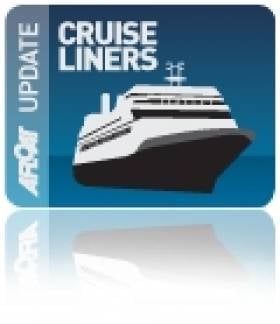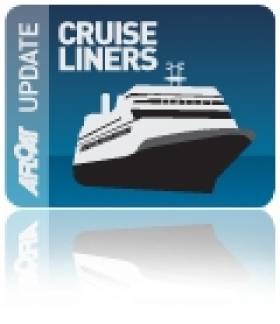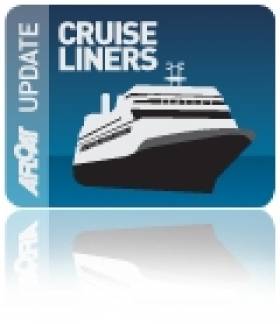Displaying items by tag: Classic International Cruises
‘Lost Weight’ Cruiseship to Call to Dublin Port
#CRUISE LINERS – Following Friday's first cruise call to Dublin Port this year of the 300-plus passenger Arion as previously reported, the considerably larger Grand Princess is to call on Wednesday. Notably on this occasion the 2,600 passenger cruiseship is to appear without her signature 'Skywalker' Nightclub, which used to be perched 18 decks-high at the aft of the vessel, writes Jehan Ashmore.
The aptly named nightclub was built on two legs to form a bridge (see PHOTO) and was accessed by a glass gangway. Not only was the structure at such an elevated position but it also overhang beyond the sheer of the stern superstructure below, where clubbers had bird's eye views over the oceans and to numerous ports of calls.
In an operation to remove the Skywalker last year, the structure weighing 211 tons took over 10 hours to complete (as previously reported including VIDEO of the work). The reason for removing the nightclub according to her owners Princess Cruises was to 'significantly improve the operational performance of the ship, including greater fuel efficiency.' For a post dry-docking view click PHOTO.
During the procedure at the Grand Bahama Shipyard in the US, the opportunity included the installation of a new nightclub three decks below and was named One5.
Ironically before the vessel lost weight!....she was the first cruiseship to visit Dublin Port to surpass the 100,000 tonnes milestone, when the leadship of the 'Grand' class docked in 2004.
From Falmouth to the Fjords
#CRUISE LINERS – Dublin Port's first cruise caller for this season will be Arion which today sets sail from Falmouth on an eleven night / twelve day cruise to Scotland and Norwegian fjords. The 5,888 gross tonnes cruiseship built in 1965 is to berth in the capital at Ocean Pier, writes Jehan Ashmore.
The veteran vessel which has sleek traditional lines can carry over 300 passengers and she is operated by Classic International Cruises. Her visit will be one of around 90 cruise calls scheduled to Dublin Port during this year's season which stretches to early October. The majority of these calls will be in the summer and where several ships will be making repeat port of calls.
With so many callers to Dublin Port, this brings a greater variety of vessels as evident between the Arion and Princess Cruises considerably larger Grand Princess which is due next week. The giant vessel weighs over 109,000 gross tonnes and has a capacity for over 4,000 passenger and crew.
The Portuguese flagged Arion is also set to open the season to Galway, as previously reported she is to make an anchorage call off the mid-west harbour next month.
Meanwhile following all the recent focus centred in Cobh, Cruise & Maritime Voyages Marco Polo is expected to arrive this afternoon by berthing at the town's dedicated cruiseship quayside.
Graceful Lady Liner to Visit Dublin
The vessel was launched as Port Sydney in 1955 from Swan Hunter and Wigham Richardson Yards, Wallsend-on-Tyne for Port Line, a subsidiary of Cunard Line. With five cargo holds, the vessel served both the meat trade and carried passengers on liner-route services between the UK and New Zealand and Australia via the Panama Canal.
In 1974, Port Sydney underwent a radical conversion into a luxury passenger cruise ship, despite the exterior appearance the vessel retains a pleasant profile compared to many modern cruiseships. Over the decades the vessel had different owners and several vessel name changes; Daphne, Switzerland and Ocean Monarch.
The most refit was in 2008 and the ship still retains the largest cabins found on any cruise ship today, of the 241 cabins. With spacious cabins for only 550 passengers and attractive appointed public areas and wide exterior decks, the veteran provides a form of cruising that would appeal to classic cruise aficionados around the world.
With a strong and sturdy hull, the vessel has a deep draft which is well suited to an ocean going vessel in handling inclement weather, though the large draft does restrict visiting certain ports and anchorage locations.
Sistership, Princess Danae, formerly Port Melbourne, was also built in 1955 with the second newbuild ordered to the famous Belfast shipbuilders, Harland & Wolff. Princess Danae is slightly smaller at 15,833grt and also made a recent call in Dublin. The sisters form part of a six vessel fleet operated by Classic International Cruises.
Princess Daphne is due to arrive in Dublin after an overnight passage from Plymouth, docking at 08.00 and depart the capital at 17.45hrs. In addition the port expects another cruise-call tomorrow in the form of Prinsendam of 37,983 grt and with over a 800-passenger capacity. The Dutch flagged vessel is operated by Holland America Line and is due to dock around mid-moring and depart at 23.30hrs.


























































